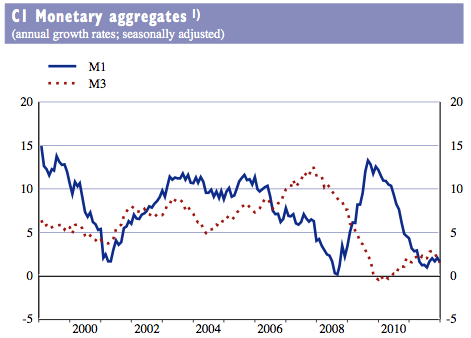
Something I neglected to mention in this morning’s post ( sorry there was just too much to say ) was Friday’s release from the ECB of Eurozone monetary aggregates. I have provide the press release at the bottom of the post, but the highlights are fairly self explanatory:
The annual growth rate of the broad monetary aggregate M3 decreased to 1.6% in December 2011, from 2.0% in November 2011.1 The three-month average of the annual growth rates of M3 in the period from October 2011 to December 2011 decreased to 2.1%, from 2.5% in the period from September 2011 to November 2011.
Regarding the main components of M3, the annual growth rate of M1 decreased to 1.6% in December 2011, from 2.1% in November. The annual growth rate of short-term deposits other than overnight deposits (M2-M1) stood at 2.1% in December, unchanged from the previous month. The annual growth rate of marketable instruments (M3-M2) decreased to -0.2% in December, from 1.1% in November. Among the deposits included in M3, the annual growth rate of deposits placed by households decreased to 1.4% in December, from 2.0% in the previous month, while the annual growth rate of deposits placed by non- financial corporations decreased to -1.0% in December, from 1.0% in the previous month. Finally, the annual growth rate of deposits placed by non-monetary financial intermediaries (excluding insurance corporations and pension funds) decreased to 0.8% in December, from 3.6% in the previous month.
And if you had any lingering doubt at all about what is occurring in Europe in regards to “zombifcation” then the next paragraph should clear it up for you:
Turning to the main counterparts of M3 on the asset side of the consolidated balance sheet of Monetary Financial Institutions (MFIs), the annual growth rate of total credit granted to euro area residents increased to 1.0% in December 2011, from 0.8% in the previous month. The annual growth rate of credit extended to general government increased to 3.6% in December, from 0.3% in November, while the annual growth rate of credit extended to the private sector decreased to 0.4% in December, from 1.0% in the previous month. Among the components of credit to the private sector, the annual growth rate of loans decreased to 1.0% in December, from 1.7% in the previous month (adjusted for loan sales and securitisation2, the rate decreased to 1.2%, from 1.9% in the previous month). The annual growth rate of loans to households decreased to 1.5% in December, from 2.1% in November (adjusted for loan sales and securitisation, the rate decreased to 1.9%, from 2.3% in the previous month). The annual growth rate of lending for house purchase, the most important component of household loans, decreased to 2.1% in December, from 3.0% in the previous month. The annual growth rate of loans to non-financial corporations decreased to 1.1% in December, from 1.6% in the previous month (adjusted for loan sales and securitisation, the rate decreased to 1.2% in December, from 1.9% in the previous month). Finally, the annual growth rate of loans to non- monetary financial intermediaries (excluding insurance corporations and pension funds) decreased to -2.0% in December, from 0.5% in the previous month.
As I have stated previously, and was mentioned by Ms Lagarde in her recent speech in the lead up to Davos, looking at European aggregate data provides a false sense of security because internal imbalances are hidden. While the broader European data in itself doesn’t look that great, some of the individual national data looks far worse:
Italian M3, a measure of monetary circulation, declined 4.5% in December from the same month of 2010, the Bank of Italy said Friday.
The sharp drop likely explains the slowdown in euro area M3, which expanded only 1.6% on the year in December, the European Central bank reported earlier in the day.
M3 in Italy, the euro zone’s third-largest economy, has declined on an annualized basis for most of the year, and has steadily decelerated from its annual pace of above 8% in 2007 and 2008.
Gavyn Davies also has some comment on the numbers including some opinion on reserve dynamics, something I talked about a few weeks ago, and additional information from the ECB can be found here.
With austerity in fiscal spending and declining M3 I find it hard to see how Europe will get out of recession. Let’s hope the EU summit can provide some credible answers.
Monetary Developments in the Euro Area – December 2011